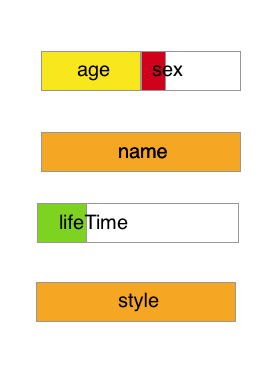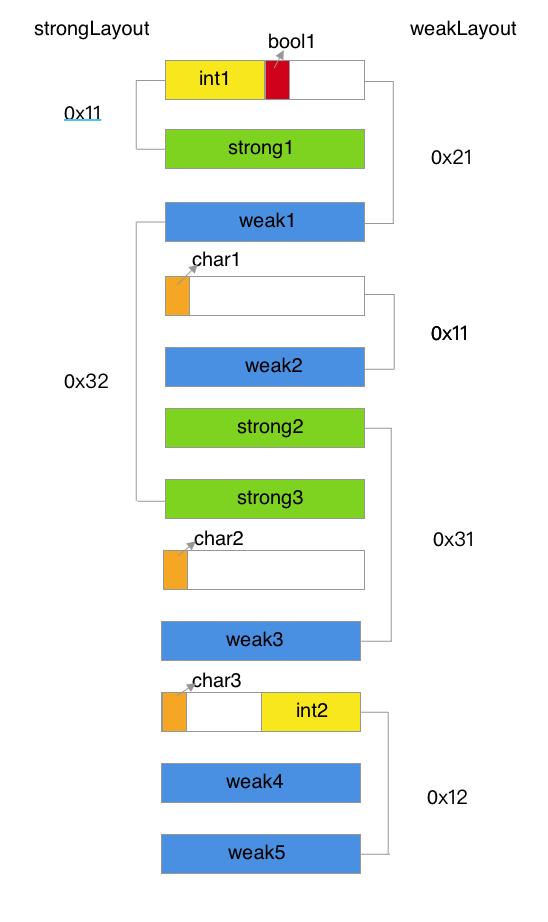随着runtime越来越常用,iOSer对runtime的理解要求也越来越高,大家都热衷于runtime源码理解,这篇我带领大家理解下关于Ivar的内容。
1.内存对齐
在分析Ivar之前,我们要了解下内存对齐的概念。
每个特定平台上的编译器都有自己的默认“对齐系数”,而64位中iOS里这个参数是8。我们测试一下:
@interface Dog : NSObject
{
int age; //4个字节
BOOL sex; //1个字节
NSString* name; //8个字节的指针地址
short lifeTime; //2个字节
NSString* style; //8个字节的指针地址
}
@end
这是我们新建的类Dog,里面有各种各样的成员变量,如果不存在内存对齐的话,会是一段连续的地址。我们打印下成员变量的地址偏移:
Class class = objc_getClass("Dog");
NSLog(@"内存地址:%p",class);
unsigned int count;
Ivar* ivars =class_copyIvarList(objc_getClass("Dog"), &count);
for (unsigned int i = 0; i < count; i++) {
Ivar ivar = ivars[i];
ptrdiff_t offset = ivar_getOffset(ivar);
NSLog(@"%s = %td",ivar_getName(ivar),offset);
}
free(ivars);
NSLog(@"Dog总字节 = %lu",class_getInstanceSize(objc_getClass("Dog")));
运行结果:
2019-03-02 14:26:53.613593+0800 Runtime-Ivar[39894:1319445] 内存地址:0x1060d6f28
2019-03-02 14:26:53.613780+0800 Runtime-Ivar[39894:1319445] age = 8
2019-03-02 14:26:53.613867+0800 Runtime-Ivar[39894:1319445] sex = 12
2019-03-02 14:26:53.613954+0800 Runtime-Ivar[39894:1319445] name = 16
2019-03-02 14:26:53.614038+0800 Runtime-Ivar[39894:1319445] lifeTime = 24
2019-03-02 14:26:53.614123+0800 Runtime-Ivar[39894:1319445] style = 32
2019-03-02 14:26:53.614234+0800 Runtime-Ivar[39894:1319445] Dog总字节 = 40
根据打印结果,sex是bool类型,应该只占1个字节,但是却好像占了4个字节,其实这里并不是占了4个字节,而是因为内存对齐,其中3个字节是没用的。我们画下内存结构图:

2.ivar的内存分布
这一部分我们从这4个方面去看ivar的分布情况。
- 属性与变量的分布
@interface Cat : NSObject
{
NSString* c1;
NSString* c4;
}
@property(nonatomic, copy)NSString* c2;
@property(nonatomic, copy)NSString* c3;
@end
unsigned int count;
Ivar* ivars =class_copyIvarList(objc_getClass("Cat"), &count);
for (unsigned int i = 0; i < count; i++) {
Ivar ivar = ivars[i];
ptrdiff_t offset = ivar_getOffset(ivar);
NSLog(@"%s = %td",ivar_getName(ivar),offset);
}
free(ivars);
NSLog(@"Cat总字节 = %lu",class_getInstanceSize(objc_getClass("Cat")));
运行结果:
2019-03-01 17:19:27.926009+0800 Runtime-Ivar[10017:6532014] c1 = 8
2019-03-01 17:19:27.926046+0800 Runtime-Ivar[10017:6532014] c4 = 16
2019-03-01 17:19:27.926056+0800 Runtime-Ivar[10017:6532014] _c2 = 24
2019-03-01 17:19:27.926065+0800 Runtime-Ivar[10017:6532014] _c3 = 32
2019-03-01 17:19:27.926097+0800 Runtime-Ivar[10017:6532014] Cat总字节 = 40
我们可以看到先是成员变量后是属性。
- 对象类型与基本类型的分布 先看下属性吧:
@interface Cat : NSObject
@property(nonatomic, copy)NSString* c1;
@property(nonatomic, assign)int c3;
@property(nonatomic, copy)NSString* c2;
@property(nonatomic, assign)int c4;
@end
打印ivar的方法和上面一致,运行后:
2019-03-01 17:11:58.167160+0800 Runtime-Ivar[9888:6528420] _c3 = 8
2019-03-01 17:11:58.167202+0800 Runtime-Ivar[9888:6528420] _c4 = 12
2019-03-01 17:11:58.167214+0800 Runtime-Ivar[9888:6528420] _c1 = 16
2019-03-01 17:11:58.167224+0800 Runtime-Ivar[9888:6528420] _c2 = 24
2019-03-01 17:11:58.167264+0800 Runtime-Ivar[9888:6528420] Cat总字节 = 32
我们可以看到属性的话先是基本类型后是对象类型。 再看下成员变量吧:
@interface Cat : NSObject
{
NSString* c1;
int c3;
NSString* c2;
int c4;
}
@end
运行结果:
2019-03-01 17:13:05.937474+0800 Runtime-Ivar[9909:6529050] c1 = 8
2019-03-01 17:13:05.937515+0800 Runtime-Ivar[9909:6529050] c3 = 16
2019-03-01 17:13:05.937526+0800 Runtime-Ivar[9909:6529050] c2 = 24
2019-03-01 17:13:05.937534+0800 Runtime-Ivar[9909:6529050] c4 = 32
2019-03-01 17:13:05.937567+0800 Runtime-Ivar[9909:6529050] Cat总字节 = 40
我们可以看到成员变量的话没有先后之分。
m文件与h文件的分布 先看属性吧:
Cat.h
@interface Cat : NSObject
@property(nonatomic, copy)NSString* c1;
@property(nonatomic, copy)NSString* c3;
@end
Cat.m
#import "Cat.h"
@interface Cat()
@property(nonatomic, copy)NSString* c2;
@property(nonatomic, copy)NSString* c4;
@end
@implementation Cat
@end
运行结果:
2019-03-01 17:16:16.989271+0800 Runtime-Ivar[9962:6530367] _c1 = 8
2019-03-01 17:16:16.989309+0800 Runtime-Ivar[9962:6530367] _c3 = 16
2019-03-01 17:16:16.989319+0800 Runtime-Ivar[9962:6530367] _c2 = 24
2019-03-01 17:16:16.989328+0800 Runtime-Ivar[9962:6530367] _c4 = 32
2019-03-01 17:16:16.989360+0800 Runtime-Ivar[9962:6530367] Cat总字节 = 40
我们可以看到先是h文件后是m文件。 再看看成员变量:
Cat.h
@interface Cat : NSObject
{
NSString* c1;
NSString* c3;
}
@end
Cat.m
#import "Cat.h"
@interface Cat()
{
NSString* c2;
NSString* c4;
}
@end
@implementation Cat
@end
运行结果:
2019-03-01 17:18:05.865890+0800 Runtime-Ivar[9992:6531268] c1 = 8
2019-03-01 17:18:05.865942+0800 Runtime-Ivar[9992:6531268] c3 = 16
2019-03-01 17:18:05.865952+0800 Runtime-Ivar[9992:6531268] c2 = 24
2019-03-01 17:18:05.865960+0800 Runtime-Ivar[9992:6531268] c4 = 32
2019-03-01 17:18:05.866000+0800 Runtime-Ivar[9992:6531268] Cat总字节 = 40
和上面一样显示h文件后是m文件。
那我们综合以上几种情况:
Cat.h
@interface Cat : Animal
{
NSString* string_h_ivar;
int int_h_ivar;
}
@property(nonatomic, copy)NSString* string_h_property;
@property(nonatomic, assign)int int_h_property;
@end
Cat.m
#import "Cat.h"
@interface Cat()
{
NSString* string_m_ivar;
int int_m_ivar;
}
@property(nonatomic, assign)int int_m_property;
@property(nonatomic, copy)NSString* string_m_property;
@end
@implementation Cat
@end
运行结果为:
2019-03-01 16:43:56.295851+0800 Runtime-Ivar[9412:6514675] string_h_ivar = 24
2019-03-01 16:43:56.295907+0800 Runtime-Ivar[9412:6514675] int_h_ivar = 32
2019-03-01 16:43:56.295917+0800 Runtime-Ivar[9412:6514675] string_m_ivar = 40
2019-03-01 16:43:56.295926+0800 Runtime-Ivar[9412:6514675] int_m_ivar = 48
2019-03-01 16:43:56.295934+0800 Runtime-Ivar[9412:6514675] _int_h_property = 52
2019-03-01 16:43:56.295942+0800 Runtime-Ivar[9412:6514675] _int_m_property = 56
2019-03-01 16:43:56.295950+0800 Runtime-Ivar[9412:6514675] _string_h_property = 64
2019-03-01 16:43:56.295960+0800 Runtime-Ivar[9412:6514675] _string_m_property = 72
2019-03-01 16:43:56.296001+0800 Runtime-Ivar[9412:6514675] Cat总字节 = 80
分析可得顺序为h文件的ivar->m文件的ivar->h文件的property基本类型->m文件的property对象类型
3.分析ivarlayout源码
在runtime.h里面关于IvarLayout的几个方法。
const uint8_t * _Nullable
class_getIvarLayout(Class _Nullable cls)
OBJC_AVAILABLE(10.5, 2.0, 9.0, 1.0, 2.0);
const uint8_t * _Nullable
class_getWeakIvarLayout(Class _Nullable cls)
OBJC_AVAILABLE(10.5, 2.0, 9.0, 1.0, 2.0);
void
class_setIvarLayout(Class _Nullable cls, const uint8_t * _Nullable layout)
OBJC_AVAILABLE(10.5, 2.0, 9.0, 1.0, 2.0);
void
class_setWeakIvarLayout(Class _Nullable cls, const uint8_t * _Nullable layout)
OBJC_AVAILABLE(10.5, 2.0, 9.0, 1.0, 2.0);
我们试用下,我们创建Person类:
@interface Person : NSObject
{
int int1;
bool bool1;
__strong NSString* strong1;
__weak NSString* weak1;
char char1;
__weak NSString* weak2;
__strong NSString* strong2;
__strong NSString* strong3;
char char2;
__weak NSString* weak3;
char char3;
int int2;
__weak NSString* weak4;
__weak NSString* weak5;
}
然后我们使用下class_getIvarLayout和class_getWeakIvarLayout:
-(void)getIvarLayout {
const uint8_t *strongLayout = class_getIvarLayout(objc_getClass("Person"));
if (!strongLayout) {
return;
}
uint8_t byte;
while ((byte = *strongLayout++)) {
printf("strongLayout = #%02x\n",byte);
}
const uint8_t *weakLayout = class_getWeakIvarLayout(objc_getClass("Person"));
if (!weakLayout) {
return;
}
while ((byte = *weakLayout++)) {
printf("weakLayout = #%02x\n",byte);
}
}
打印结果:
strongLayout = #11
strongLayout = #32
weakLayout = #21
weakLayout = #11
weakLayout = #31
weakLayout = #12
粗一看看不出什么,文档里面并没有详细说明layout的含义,我们要探究IvarLayout的话,还是要在源码找线索。
void fixupCopiedIvars(id newObject, id oldObject)
{
for (Class cls = oldObject->ISA(); cls; cls = cls->superclass) {
if (cls->hasAutomaticIvars()) {
// Use alignedInstanceStart() because unaligned bytes at the start
// of this class's ivars are not represented in the layout bitmap.
size_t instanceStart = cls->alignedInstanceStart();
const uint8_t *strongLayout = class_getIvarLayout(cls);
if (strongLayout) {
id *newPtr = (id *)((char*)newObject + instanceStart);
unsigned char byte;
while ((byte = *strongLayout++)) {
unsigned skips = (byte >> 4);
unsigned scans = (byte & 0x0F);
newPtr += skips;
while (scans--) {
// ensure strong references are properly retained.
id value = *newPtr++;
if (value) objc_retain(value);
}
}
}
const uint8_t *weakLayout = class_getWeakIvarLayout(cls);
// fix up weak references if any.
if (weakLayout) {
id *newPtr = (id *)((char*)newObject + instanceStart), *oldPtr = (id *)((char*)oldObject + instanceStart);
unsigned char byte;
while ((byte = *weakLayout++)) {
unsigned skips = (byte >> 4);
unsigned weaks = (byte & 0x0F);
newPtr += skips, oldPtr += skips;
while (weaks--) {
objc_copyWeak(newPtr, oldPtr);
++newPtr, ++oldPtr;
}
}
}
}
}
}
这一段源码是runtime如何使用strongLayout和weakLayout。
下面,我们仔仔细细的分析这段源码,我们取出其中关键的一部分,先看关于strongLayout:
//获得strongLayout的数组,数组元素类型为uint8_t,uint8_t为2位16进制数
const uint8_t *strongLayout = class_getIvarLayout(cls);
if (strongLayout) {
//newPtr为ivar的初始地址
id *newPtr = (id *)((char*)newObject + instanceStart);
unsigned char byte;
//遍历strongLayout,并且将内容赋值给byte
while ((byte = *strongLayout++)) {
//取出byte的左边一位
unsigned skips = (byte >> 4);
//取出byte的右边一位
unsigned scans = (byte & 0x0F);
//地址跳过skips位
newPtr += skips;
//循环scans次
while (scans--) {
// ensure strong references are properly retained.
//取出地址里的内容,并且地址+1
id value = *newPtr++;
if (value) objc_retain(value);
}
}
}
从这一段源码,我们可以看到scans的地址值存放的是strong的成员变量,而skips是无效值,同样我们也可以分析weakLayout的那一段源码。为了能更加清晰的看到ivar的布局,我们通过ivar_getOffset方法获得ivar的内存布局。
-(void)getOffset {
unsigned int count;
Ivar* ivars =class_copyIvarList(objc_getClass("Person"), &count);
for (unsigned int i = 0; i < count; i++) {
Ivar ivar = ivars[i];
ptrdiff_t offset = ivar_getOffset(ivar);
NSLog(@"%s = %td",ivar_getName(ivar),offset);
}
free(ivars);
NSLog(@"Person总字节 = %lu",class_getInstanceSize(objc_getClass("Person")));
}
运行结果:
2019-03-04 10:27:23.147813+0800 Runtime-Ivar[32952:841600] int1 = 8
2019-03-04 10:27:23.147842+0800 Runtime-Ivar[32952:841600] bool1 = 12
2019-03-04 10:27:23.147853+0800 Runtime-Ivar[32952:841600] strong1 = 16
2019-03-04 10:27:23.147863+0800 Runtime-Ivar[32952:841600] weak1 = 24
2019-03-04 10:27:23.147875+0800 Runtime-Ivar[32952:841600] char1 = 32
2019-03-04 10:27:23.147884+0800 Runtime-Ivar[32952:841600] weak2 = 40
2019-03-04 10:27:23.147894+0800 Runtime-Ivar[32952:841600] strong2 = 48
2019-03-04 10:27:23.147904+0800 Runtime-Ivar[32952:841600] strong3 = 56
2019-03-04 10:27:23.147913+0800 Runtime-Ivar[32952:841600] char2 = 64
2019-03-04 10:27:23.147922+0800 Runtime-Ivar[32952:841600] weak3 = 72
2019-03-04 10:27:23.147932+0800 Runtime-Ivar[32952:841600] char3 = 80
2019-03-04 10:27:23.147941+0800 Runtime-Ivar[32952:841600] int2 = 84
2019-03-04 10:27:23.147950+0800 Runtime-Ivar[32952:841600] weak4 = 88
2019-03-04 10:27:23.147959+0800 Runtime-Ivar[32952:841600] weak5 = 96
2019-03-04 10:27:23.147992+0800 Runtime-Ivar[32952:841600] Cat总字节 = 104
通过这个我们可以画出内存布局图:

strongLayout和weakLayout加到上面去:

strong还是weak都是对象类型的变量,存的都是指针地址,所以占8位。所以源码中的scan地址,其实就是存的strong或者weak的指针地址。我们可以看到在strongLayout中,高位x8代表非strong类型所占的内存地址,低位代表strong类型的个数,在weakLayout中,高位x8代表非weak类型所占的内存地址,低位代表weak类的个数。